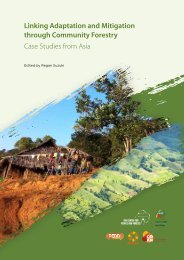Desktop Study on - Regional Climate Change Adaptation ...
Desktop Study on - Regional Climate Change Adaptation ...
Desktop Study on - Regional Climate Change Adaptation ...
Create successful ePaper yourself
Turn your PDF publications into a flip-book with our unique Google optimized e-Paper software.
<str<strong>on</strong>g>Desktop</str<strong>on</strong>g> <str<strong>on</strong>g>Study</str<strong>on</strong>g><br />
capacity, including the new support of data from Viet<br />
Nam’s own satellite (Chaudhry and Ruysschaert,<br />
2007).<br />
Instituti<strong>on</strong>al resp<strong>on</strong>ses<br />
A Nati<strong>on</strong>al Target Programme <strong>on</strong> Poverty Reducti<strong>on</strong><br />
during 2006 to 2010 has been set up with the goal<br />
to reduce the poverty rate from 22% in 2005 to 10<br />
or 11% in 2010 (Viet Nam News, 2009). A nati<strong>on</strong>al<br />
report presented in October 2009 by the Ministry of<br />
Labour, Invalids and Social Affairs indicates that Viet<br />
Nam is <strong>on</strong> target to achieve a 10% reducti<strong>on</strong> already<br />
by the end 2009, the poverty rate being 12.8% (2.2<br />
milli<strong>on</strong> people) at the end of 2008. The funds of the<br />
program are used for building infrastructure in most<br />
disadvantages coastal and island areas, providing<br />
the poor with credit loans and reduced fees for<br />
vocati<strong>on</strong>al training, health insurance, houses, as<br />
well as free legal aid. However, the report also<br />
c<strong>on</strong>cluded that more people are becoming poor<br />
due to Viet Nam’s socio-ec<strong>on</strong>omic c<strong>on</strong>text, which<br />
leads to an inaccurate assessment of the number of<br />
poor households, due to insufficient administrative<br />
capacity of the involved agencies, which makes<br />
further efforts necessary (Viet Nam News, 2009).<br />
Gaps Identified in Programs and<br />
Studies<br />
Viet Nam could achieve important progress in<br />
its disaster early warning systems in the past<br />
years, including a nati<strong>on</strong>al typho<strong>on</strong> warning<br />
system, broadcast via media and loudspeakers,<br />
and a c<strong>on</strong>tinuous m<strong>on</strong>itoring of dykes during the<br />
typho<strong>on</strong> seas<strong>on</strong> (Chaudhry and Ruysschaert, 2007).<br />
N<strong>on</strong>etheless, large losses are still occurring. Overall,<br />
collecti<strong>on</strong> and communicati<strong>on</strong> of informati<strong>on</strong> within<br />
the disaster early warning system still need to be<br />
improved (Chaudhry and Ruysschaert, 2007).<br />
Also, whereas the better-off households have seen<br />
a reduced vulnerability to disaster risks through<br />
improved sea defence, the poor populati<strong>on</strong><br />
still remains extremely vulnerable due to their<br />
livelihoods’ dependency <strong>on</strong> agriculture and fishery<br />
and the inability to individually cope with disaster<br />
risks due to the lack of alternative ec<strong>on</strong>omic<br />
opportunities (Chaudhry and Ruysschaert, 2007).<br />
Furthermore, the nati<strong>on</strong>al report recently published<br />
<strong>on</strong> the mid-term review of the Nati<strong>on</strong>al Target<br />
Program <strong>on</strong> Poverty Reducti<strong>on</strong> puts forward that<br />
due to insufficient administrative capacity of the<br />
agencies involved in the program, not all households<br />
living below the poverty line have been listed as poor<br />
(Viet Nam News, 2009). Besides the need for capacity<br />
building for the involved administrative agencies, it<br />
is proposed to c<strong>on</strong>sider a variety of criteria in the<br />
regularly to be updated list of poor households, not<br />
<strong>on</strong>ly the income level (Viet Nam News, 2009).<br />
Chaudhry and Ruysschaert (2007) identified that<br />
the government’s home relocati<strong>on</strong> program faces<br />
barriers such as delays in the realizati<strong>on</strong> of the large<br />
scale program as well as resistance from the part<br />
of the c<strong>on</strong>cerned populati<strong>on</strong>. The new settlement<br />
locati<strong>on</strong>s limit the access to the people’s fields and<br />
canals, not <strong>on</strong>ly in flood but also in n<strong>on</strong>-flood times,<br />
which curtails the people’s fishing activity that is a<br />
critical livelihood strategy. In general, resource rights<br />
and opportunities are unequally allocated between<br />
well-off households and the poor, which represents<br />
a primary c<strong>on</strong>straint for the poor to effectively adapt<br />
to climate change. Overall Viet Nam’s populati<strong>on</strong> that<br />
is most at risk from climate change is the rural poor<br />
in the most affected province. For those, there is<br />
still insufficient informati<strong>on</strong>, financial and technical<br />
support for climate change adaptati<strong>on</strong> (Chaudhry<br />
and Ruysschaert, 2007).<br />
Although the threat of climate change has started to<br />
be acknowledged, informati<strong>on</strong> and awareness are still<br />
insufficiently developed (Chaudhry and Ruysschaert,<br />
2007). Potential impacts and adaptati<strong>on</strong> needs are<br />
to be made known to Viet Nam’s populati<strong>on</strong> bey<strong>on</strong>d<br />
the experts and development workers and some<br />
agencies. Communicati<strong>on</strong> needs to be strengthened<br />
and l<strong>on</strong>g-term research <strong>on</strong> potential impacts <strong>on</strong> Viet<br />
Nam’s ec<strong>on</strong>omy and development goals, especially<br />
c<strong>on</strong>cerning poverty reducti<strong>on</strong>, as well as projecti<strong>on</strong>s<br />
regarding climate refugees due to sea level rise are<br />
needed (Chaudhry and Ruysschaert, 2007).<br />
Recent Projects with Socio-Ec<strong>on</strong>omic<br />
Sector<br />
According to the matrix of climate change activities<br />
elaborated by the World Bank (2009b), the following<br />
projects were identified for the socio-ec<strong>on</strong>omic<br />
sector: (i) Evidence Based Natural Disaster Risk<br />
Management, An Empirical Applicati<strong>on</strong> from Viet<br />
Nam, is being funded by GFDRR and implemented<br />
by MARD. Am<strong>on</strong>g its objectives are, estimating the<br />
welfare and ec<strong>on</strong>omic growth costs associated<br />
with different natural disasters and developing<br />
a disaggregated vulnerability map reflecting the<br />
percent of people likely to fall below a certain poverty<br />
threshold in the future; (ii) carried out by UNDP (with<br />
MoNRE), the Scoping research <strong>on</strong> <strong>Climate</strong> change<br />
and the Poor in Viet Nam project is a technical study<br />
of the linkage between climate change and poverty;<br />
(iii) the UNDP has also the project <strong>Climate</strong> change<br />
and Gender study, that studies the implicati<strong>on</strong>s and<br />
44

















